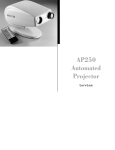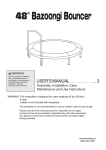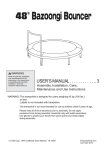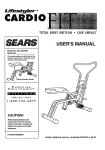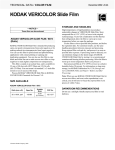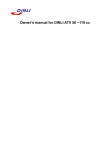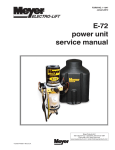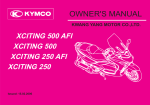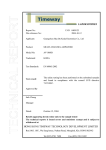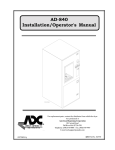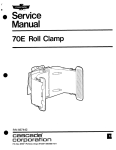Download American Dryer Corp. Water Vending Machine AD-830 Installation manual
Transcript
AD-830 Installation Manual For replacement parts, contact the reseller from which the machine was purchased or American Dispensing Company 88 Currant Road Fall River MA 02720-4781 Telephone: (508) 678-9000 / Fax: (508) 678-9447 E-mail: [email protected] 081696OC ADC Part No. 182714 Retain This Manual In A Safe Place For Future Reference American Dispensing Company products embody advanced concepts in engineering, design, and safety. If this product is properly maintained, it will provide many years of safe, efficient, and trouble-free operation. ONLY properly licensed technicians should service this equipment. OBSERVE ALL SAFETY PRECAUTIONS displayed on the equipment or specified in the installation manual included with the water vending machine. WARNING: UNDER NO CIRCUMSTANCES should the pressure switch(es) or other safety devices ever be disabled. We have tried to make this manual as complete as possible and hope you will find it useful. ADC reserves the right to make changes from time to time, without notice or obligation, in prices, specifications, colors, and material, and to change or discontinue models. Important For your convenience, log the following information: DATE OF PURCHASE ____________________________ MODEL NO. AD-830 __________________________________________ RESELLER’S NAME _______________________________________________________________________________________ Serial Number(s) ________________________________________________________________________________________ ________________________________________________________________________________________ ________________________________________________________________________________________ Replacement parts can be obtained from your reseller or the ADC factory. When ordering replacement parts from the factory, you can FAX your order to ADC at (508) 678-9447 or telephone your order directly to the ADC Parts Departmentat (508) 678-9000. Please specify the water vending machine model number and serial number in addition to the description and part number, so that your order is processed accurately and promptly. The illustrations on the following pages may not depict your particular water vending machine exactly. The illustrations are a composite of the various water vending machine models. Be sure to check the descriptions of the parts thoroughly before ordering. IMPORTANT YOU MUST DISCONNECT and LOCKOUT THE ELECTRIC SUPPLY BEFORE ANY COVERS or GUARDS ARE REMOVED FROM THE MACHINE TO ALLOW ACCESS FOR CLEANING, ADJUSTING, INSTALLATION, or TESTING OF ANY EQUIPMENT per OSHA (Occupational Safety and Health Administration) STANDARDS. CAUTION LABEL ALL WIRES PRIOR TO DISCONNECTION WHEN SERVICING MACHINE. WIRING ERRORS CAN CAUSE IMPROPER and DANGEROUS OPERATION. FOR YOUR SAFETY THE SYSTEM IS SHIPPED WITH A PRESERVATIVE SOLUTION MADE OF SODIUM BISULFITE (IN THE WINTER MONTHS) GLYCERINE. MAKE SURE THE SYSTEM IS THOROUGHLY PURGED BEFORE LETTING ANYONE DRINK THE DISPENSED WATER. REFER TO THE INSTALLATION SECTION ON PURGING PROCEDURE. CAUTION Never look directly into the unprotected parts of the U.V. chamber when there is power to the sterilizer. Serious burns to the eyes and skin may result. Always unplug power to the sterilizer before working on it. IMPORTANT Please observe ALL safety precautions displayed on the equipment and specified in this manual. IMPORTANT The wiring diagram for the water vending machine is located on the inside right wall of the machine. Water vending machines must not be installed or stored in an area where it will be exposed to water or weather. Table of Contents SECTION I IMPORTANT INFORMATION ............................................................................... 3 A. Receiving and Handling ............................................................................................................... 3 B. Safety Precautions ...................................................................................................................... 3 SECTION II SPECIFICATIONS/COMPONENT IDENTIFICATION .................................... 5 A. Specifications ............................................................................................................................. 5 SECTION III INSTALLATION PROCEDURES ........................................................................... 9 A. B. C. D. E. F. Location Requirements ............................................................................................................... 9 System Description ..................................................................................................................... 9 Water Supply ........................................................................................................................... 10 Feed Water and Drain Plumbing ................................................................................................ 11 Electrical Information ................................................................................................................ 11 Unpacking/Setting Up ............................................................................................................... 12 SECTION IV SERVICE and PARTS INFORMATION .............................................................. 15 A. Resetting The Microprocessor .................................................................................................. 15 B. Service ..................................................................................................................................... 15 C. Parts ........................................................................................................................................ 15 SECTION V WARRANTY INFORMATION .............................................................................. 16 A. Returning Warranty Card(s) ...................................................................................................... 16 B. Warranty .................................................................................................................................. 16 C. Returning Warranty Part(s) ........................................................................................................ 16 SECTION VI MAINTENANCE SCHEDULE............................................................................... 18 SECTION VII FILTER MAINTENANCE ...................................................................................... 22 A. Water Filter/Strainer Replacement ............................................................................................. 22 B. Air Filter Inspection and Replacement ....................................................................................... 23 SECTION VIII REVERSE OSMOSIS (R.O.) MEMBRANE ........................................................ 24 A. Product Water Flow Rate Measurement .................................................................................... 24 B. Membrane Cleaning .................................................................................................................. 27 C. Storage and Shipping of Membrane .......................................................................................... 30 SECTION IX ULTRAVIOLET (U.V.) STERILIZER .................................................................... 32 A. Ultraviolet (U.V.) Lamp Replacemet Procedure ......................................................................... 32 B. Quartz Sleeve and Cleaning Procedure ...................................................................................... 33 C. Ultraviolet (U.V.) Probe Cleaning Procedure ............................................................................. 34 SECTION X MISCELLANEOUS MAINTENANCE TECHNIQUES ..................................... 35 A. Drain Bay Cleaning ................................................................................................................... 35 B. Vending Nozzle Adjustment ....................................................................................................... 36 C. Tubing and Fitting Replacement Technique ................................................................................. 36 SECTION XI TROUBLESHOOTING ........................................................................................... 38 SECTION I IMPORTANT INFORMATION A. RECEIVING and HANDLING The water vending machine is shipped in a protective stretch wrap cover with protective cardboard corners and top cover (or optional box) as a means of preventing damage in transit. Upon delivery, the water vending machine, packaging material, and wooden skid should be visually inspected for shipping damage. If any damage is noticed, inspect further before delivering carrier leaves. Water vending machines damaged in shipment: 1. ALL water machines should be inspected upon receipt and before they are signed for. 2. If there is suspected damage or actual damage, the trucker’s receipt should be so noted. 3. If the water vending machine is damaged beyond repair, it should be refused. Those water vending machines, which were not damaged in a shipment should be accepted, but the number received and the number refused must be noted on the receipt. 4. If you determine that the water vending machine was damaged after the trucker has left your location, you should call the delivering carrier’s freight terminal immediately and file a claim. The freight company considers this concealed damage. This type of freight claim is very difficult to get paid and becomes extremely difficult when more than a day or two passes after the freight was delivered. It is your responsibility to file freight claims. Water vending machines and parts damaged in transit cannot be claimed under warranty. 5. Freight claims are the responsibility of the consignee, and claims must be filed at the receiving end. ADC assumes no responsibility for freight claims or damages. 6. If you need assistance in handling the situation, please contact the ADC Traffic Manager at (508) 678-9000. IMPORTANT: The water vending machine must be transported and handled in an upright position at ALL times. B. SAFETY PRECAUTIONS IMPORTANT: Refer to this manual before making any repairs or adjustments, or doing any maintenance on this machine. IMPORTANT: For owners who DO NOT personally maintain the machine, it is their responsibility that the operator has been properly instructed and is fully aware of the manual contents. This is important in the safe handling and efficient operation of the machine. 3 IMPORTANT: Follow maintenance schedule rigorously. Careless maintenance may lead to component failure and increase operating costs significantly. CAUTION: DO NOT make any alteration or modification in the wiring or plumbing of this machine. Such alterations may result in injury, illness, or death to maintenance personnel, operators, or users of this machine. WARNING: DO NOT allow machine to freeze. Freezing will irreparably damage components in the machine. NOTE: NEVER LOOK DIRECTLY INTO THE UNPROTECTED PARTS OF THE U.V. CHAMBER WHEN THERE IS POWER TO THE STERILIZER. SERIOUS BURNS TO THE EYES and SKIN MAY RESULT. ALWAYS UNPLUG POWER TO THE STERILIZER BEFORE WORKING ON IT. NOTE: THE SYSTEM IS SHIPPED WITH A PRESERVATIVE SOLUTION MADE OF SODIUM BISULFITE and (IN THE WINTER MONTHS) GLYCERINE. MAKE SURE THE SYSTEM IS THOROUGHLY PURGED BEFORE LETTING ANYONE DRINK THE DISPENSED WATER. SEE SECTION III ON INSTALLATION PROCEDURES. DISCLAIMER The information contained in this document is subject to change without notice. American Dispensing Company shall not be liable for technical or editorial omissions made herein; nor incidental or consequential damages resulting from the furnishing, performance, or use of this material. 4 SECTION II SPECIFICATIONS/COMPONENT IDENTIFICATION A. SPECIFICATIONS Reverse Osmosis (R.O.) MembraneCapacity 1,200 gallons* 4.542.2 liters* 3/4 HP 0.55 kw Dispensing Pump 3 gallon/minute 11.36 liters/minute Drain Pump 3 gallon/minute 11.36 liters/minute R.O. Pump Water Vending Machines Per 20'/40 10/20 Water Vending Machines Per 45'/48 24/26 Voltage Available 115-240v 1Ø 50/60 Hz Approximate Weight (Uncrated Empty) 1100 lbs. 498.9 kg Approximate Weight (Uncrated Full/Capacity) 1700 lbs. 771.1 kg Approximate Weight (Crated) 1200 lbs. 544.3 kg Water Inlet Size 1/2 N.P.T. ** Drain Outlet Size 1/2 N.P.T. ** Storage Tank Size 93 gallons 352 liters * These specifications are calculated at 2,000 ppm, total sodium chloride solution at 77º F (25º C) feed water temperature and 160 PSI (11.03 bars) reverse osmosis (R.O.) pump pressure. ** MUST BE CONNECTED TO A MINIMUM 3/4” N.P.T. INLET WATER SUPPLY. 1. Minimum Pressure Inlet Flow Rate 4 gallons (15.14 liters) a minute at 35 PSI. (2.41 bars) back pressure or the equivalent of 9 gallons (34.06 liters) per minute at a free flowing 1/2” N.P.T. outlet at the intended location of the machine. This test should be conducted with ALL other equipment connected to the same water line running to reflect true flow. 2. Maximum Water Pressure 80 PSI. (5.51 bars). Install a pressure regulator if incoming water pressure exceeds this level. High inlet pressure will irreparably damage filter housings and cause leaks in the system. 5 6 B. COMPONENT IDENTIFICATION 7 VENDING SOLENOIDS INLET VALVE PROGRAMMING SWITCH DISPLAYS R.O. PRESSURE REGULATOR TRAP DOORS INLET SOLENOID EXPANSION TANK COMPUTER DOUBLE CHECK VALVE LOW PRESSURE SWITCH REAR ELECTRICAL TEST CELL HIGH PRESSURE SWITCH TRA VIOLET STERILIZE CARBON FILTER SEDIMENT FILTER R.O. FILTER POLISHING FILTER 8 SECTION III INSTALLATION PROCEDURES Installation should be performed by competent technicians in accordance with local and state codes. In the absence of these codes, the installation must conform to applicable American National Standards: ANSIZ223.1LATEST EDITION (National Fuel Gas Code) or ANSI/NFPA NO. 70-LATEST EDITION (National Electrical Code) or in Canada, the installation must confirm to applicable Canadian Standards: CAN/CGA-B149.1-M91 (Natural Gas) or CAN/CGA-B149.2-M91 (Liquid Propane [L.P.] Gas) or LATEST EDITION (for General Installation and Gas Plumbing) or Canadian Electrical Codes Parts 1 & 2 CSA C22.1-1990 or LATEST EDITION (for Electrical Connections). A. LOCATION REQUIREMENTS WARNING: Feed water must come from inspected, approved water system only. Source must be microbiologically safe drinking water. 1. The water vending machine must be installed on a sound level floor capable of supporting its weight. It is recommended that carpeting be removed from the floor that the water vending machine is to rest on. 2. The water vending machine must not be installed or stored in an area where it will be exposed to water and weather. 3. Provisions for adequate water supply must be provided as noted in this manual. (Refer to Water Supply in Section C). 4. Plumbing should be performed in accordance to local, state and federal codes. (Refer to Feed Water and Drain Plumbing in Section D). 5. Provisions must be made for adequate clearances for servicing and for operation as noted in this manual. (Refer to Enclosure Requirements in Section II). B. SYSTEM DESCRIPTION Thank you for purchasing the model AD-840 water vending machine. It is made by American Dispensing Company and is one (1) of the most advanced water vending machines on the market today. It is microprocessorbased and programmable. It interacts with the customer and owner through a light emitting diode (L.E.D.) display and a membrane keyboard (touch pad). The AD-830 purifies water through a five-step process: Incoming water first passes through a 10-micron absolute SEDIMENT FILTER. This means that suspended solids larger than 0.01 mm (or about forty-thousands of 1-inch) such as slit and fine sand are removed. Water then passes through a CARBON FILTER. This removes chlorine, odor, and a variety of organic contaminants, such as chloroform and pesticide residue. The AD-830 uses a carbon filter with an extruded carbon core and an inner filtration wrap. This combination ensures that, unlike a conventional granular activated carbon (G.A.C.) filter, there is no channeling or bypassing, and no release of fine carbon particles. 9 Water is then pumped through a thin film composite reverse osmosis (R.O.) membrane at about 160 PSI (11.03 bars). The R.O. membrane removes over ninety percent (90%) of a variety of salts and inorganic materials found in water, such as dissolved salts of sodium, lead, nitrate; it removes typically over ninety-nine percent (99%) of radioactivity, like radon. Actual rejection rate will depend on feed water chemistry, temperature, and its total dissolved solid content. Water is then stored in an atmospheric water tank, sealed except for an air vent, which is protected from dust and airborne bacteria by a submicron air filter. When your customer selects a vend, water will be pumped through a combination sediment/carbon POLISHING FILTER which removes any remaining taste and sediment, and an ULTRAVIOLET (U.V.) STERILIZER which sterilizes the water. To keep the stored water fresh and sterilized, the water in the storage tank is recirculated through the polishing filter and the U.V. sterilizer periodically. Safety is our prime concern and it is designed into the machine. At the inlet and outlet of the R.O. membrane, a comparator reads the total dissolved solid rejection rate, an indicator of the performance of the membrane. If the rejection rate falls below a certain level, the microprocessor will shut the machine down. The same logic applies to the U.V. sterilizer, where a true U.V. sensor continually monitors the disinfecting power of the light and shuts down the machine when the U.V. level is not high enough. There is also overflow and leakage protection. The sensors are located on the base of the machine, in the drain tank of the dispensing bay and in the water storage tank. These sensors detect overflow or leakage and will shut off whatever components are necessary. NOTE: The machine is approved by the NATIONAL AUTOMATIC MERCHANDISING ASSOCIATION (NAMA) in Chicago. In many states, this is a requirement for water vending machine installation. C. WATER SUPPLY The following conditions are required for optimum performance: WARNING: FEED WATER MUST COME FROM INSPECTED, APPROVED WATER SYSTEMS ONLY. SOURCE MUST BE MICROBIOLOGICALLY SAFE DRINKING WATER. 1. Minimum Pressure/Inlet Flow Rate 4 gallons (15.14 liters) a minute at 35 PSI (2.41 bars) back pressure or the equivalent of 9 gallons (34.06 liters) per minute at a free flowing 1/2” N.P.T. outlet at the intended location of the machine. This test should be conducted with ALL other equipment connected to the same water line running to reflect true flow. 2. Maximum Water Pressure The maximum water pressure is 80 PSI (5.51 bars). Install a pressure regulator if incoming water pressure may exceed this level. High inlet pressure will irreparably damage filter housing and cause leaks in the system. 10 3. Temperature This machine should be kept in an environment between 40° F and 108º F (4.44° and 42.22°). Exposing the machine to freezing temperatures will irreparably damage the components. 4. Mineral Content Pretreatment of incoming water is recommended if hardness exceeds 150 ppm or 9 grains per gallon, or if iron levels exceed 0.05 ppm. Membrane will still function with high mineral content water, but yield will drop substantially, membrane cleaning is required more frequently, and membrane life will be shortened significantly, increasing overall operating costs. D. FEED WATER and DRAIN PLUMBING 1. Inlet and outlet of the machine are 1/2” N.P.T., female threads. Use for connection only sanitary plumbing materials appropriate for drinking water. NOTE: Minimum 3/4” N.P.T. inlet water supply. 2. Drain outlet should have a minimum of a 2-inch (5.08 cm) air gap at the point of discharge. Follow ALL applicable plumbing codes when making connections. E. ELECTRICAL INFORMATION 1. Electrical Requirements It is your responsibility to have ALL electrical connections made by a properly licensed and competent electrician to assure that the electrical installation is adequate and conforms to local and state regulations or codes. In absence of such codes, ALL electrical connections, material, and workmanship must conform to the applicable requirements of the National Electrical Code ANSI/NFPA NO. 70-LATEST EDITION or in Canada, the Canadian Electrical Codes Parts 1 & 2 CSA C22.1-1990 or LATEST EDITION. IMPORTANT: Failure to comply with these codes or ordinances and requirements stipulated in this manual can result in personal injury or component failure. NOTE: Component failure due to improper installation will VOID THE WARRANTY. Each water vending machine should be connected to an independently protected branch circuit. The water vending machine must be connected with copper wire only. DO NOT use aluminum wire, which could cause a fire hazard. The copper conductor wire or cable must be of proper ampacity and insulation in accordance with electric codes for making ALL service connections. NOTE: The use of aluminum wire will VOID THE WARRANTY. 11 2. Electrical Specifications AD-830 ELECTRICAL SERVICE SPECIFICATIONS (PER WATER VENDING MACHINE) IMPORTANT: 208 VAC and 230/ 240 VAC ARE NOT THE SAME. When ordering, specify exact voltage. NOTES: A. Fuse ratings are dual element time delay current limiting, class RK1 or RK5 ONLY. B. Circuit breakers are thermal magnetic (industrial) type only. For others, calculate/verify correct breaker size according to appliance amp draw rating and type of breaker used. SERVICE WIRE PHASE VOLTAGE SERVICE APPROX. AMP DRAW 50 Hz 60 Hz MINIMUM WIRE SIZE* FUSING Dual Element Time Delay CIRCUIT BREAKER 115 1ø 2 15 14 12 25 30 208 1ø 2 8 7 14 12 15 230/240 1ø 2 8 7 14 12 15 * AWG Stranded Type Wire for individual lengths less than 100 feet (31 meters). IMPORTANT: The water vending machine must be connected to the electric supply shown on the data label that is affixed to the back of the water vending machine, at the upper right hand corner. In the case of 208 VAC or 230/240 VAC, the supply voltage must match the electric service specifications of the data label exactly. WARNING: 208 VAC and 230/240 VAC ARE NOT THE SAME. Any damage done to water vending machine components due to improper voltage connections will automatically VOID THE WARRANTY. NOTE: ADC reserves the right to make changes in specifications at any time without notice or obligation. F. UNPACKING/SETTING UP ATTENTION: CHECK STATE and LOCAL LAWS REGARDING THE OPERATION OF WATER VENDING MACHINES BEFORE INSTALLATION. SOME STATES REQUIRE VENDORS TO NOTIFY THE DEPARTMENT OF PUBLIC HEALTH or WEIGHTS and MEASURES CONCERNING THE INSTALLATION OF THE MACHINE. FOLLOW ALL APPLICABLE FEDERAL, STATE and LOCAL STANDARDS FOR DRINKING WATER INSTALLATIONS. ATTENTION: BE SURE THE INSTALLATION OF THIS MACHINE COMPLIES WITH ALL LOCAL PLUMBING and ELECTRICAL CODES. WARNING: DO NOT CONNECT ELECTRICAL POWER TO MACHINE UNTIL REQUESTED. 12 1. Remove the wrappings of the vending machine and check for transit damage. Notify carrier if there is damage. 2. Skid can be removed by unscrewing four (4) 5/16” skid bolts at the legs of the machine. 3. Place machine at the intended location and, if required, adjust the 3/4” bolts at the legs until the machine is level and stable. 4. Connect plumbing inlet and outlet lines. Refer to guidelines in the section “SITE REQUIREMENTS.” 5. Reconnect reverse osmosis (R.O.) membrane (refer to page 13). ATTENTION The reverse osmosis (R.O.) membrane in this machine is filled with a preservative solution and plugged for shipping. The two lengths of tubing illustrated below will have to be reconnected before machine start-up. (Refer to diagrams to right). Refer to “Miscellaneous Maintenance Technique, Section C” on page 35 of the installation manual for tubing removal and attachment technique. Push tubing into fittings firmly to prevent leakage. CAUTION: WEAR PROTECTIVE CLOTHING, GLOVES, and SAFETY GLASSES WHEN RECONNECTING TUBING. THE PRESERVATIVE SOLUTION CONTAINS SODIUM BISULFITE and GLYCERINE and MAY CAUSE SKIN and EYE IRRITATION IN SOME INDIVIDUALS. WIPE UP ALL SPILLS IMMEDIATELY. 6. Open the main water ball valve located inside the cabinet at the water inlet of the machine. 7. Plug machine into the electrical outlet. (Refer to Electrical Information, Section E on page 11). WARNING: THE MACHINE IS SHIPPED WITH A PRESERVATIVE SOLUTION MADE OF SODIUM BISULFITE and (IN THE WINTER MONTHS) GLYCERINE. MAKE SURE THE SYSTEM IS THOROUGHLY PURGED BEFORE LETTING ANYONE DRINK THE DISPENSED WATER. (SEE STEP #9 and STEP #10). 8. The display should blink the message: “SYSTEM” “PURGE” “DO NOT” “DRINK.” Purge cycle starts automatically. Clear the dispensing bay of obstacles, as water will come out of the dispensing valve and into the drain basin. Discard ALL water dispensed until purge cycle is over. Cycle is over when the display blinks “INSERT” and “COIN” or the amount for 1 gallon (3.78 liters). 13 Several minutes into the purge cycle, check the following: a. Pressure gauge at the reverse osmosis (R.O.) pump on the base of the cabinet should read between 140 and 180 PSI (9.65 and 12.41 bars) with the pump running (refer to diagram 1). If it is not within range, adjust back pressure valve to return reading to 160 PSI (11.03 bars). Back pressure valve is located near the drain outlet. Unscrew cap and loosen locknut. Turn adjusting bolt into valve for higher back pressure and vice versa. Tighten locknut and replace cap. DIAGRAM 1 b. Visually note any leaks in the system. When the dispensing valve opens again during purge cycle, check for leaks on the dispensing side at this time. 9. Take a sample of the dispensed water after the purge cycle is over. Smell the water to ensure no odor is present. If there is, dispense water until water is free of odor. 10. The water is ready for vending. ATTENTION: MEASURE THE INITIAL FLOW RATE OF THE PRODUCT WATER FROM THE R.O. MEMBRANE WITHIN 24 TO 48 HOURS OF NEW MACHINE OPERATION. REFER TO REVERSE OSMOSIS (R.O.) MEMBRANE IN SECTION VIII, FOR PROCEDURE. THIS IS IMPORTANT AS IT DETERMINES WHEN MEMBRANE NEEDS TO BE CLEANED IN THE FUTURE. ATTENTION: TO REDUCE BIOFOULING, IT IS RECOMMENDED THAT A MINIMUM OF 12 GALLONS (45.42 LITERS) BE VENDED EVERY 72 HOURS. THE LESS THE IDLE TIME BETWEEN VENDS, THE LESS LIKELY BIOFOULING IS TO OCCUR IN THE R.O. MEMBRANE and THE FILTERS. 14 SECTION IV SERVICE and PARTS INFORMATION A. RESETTING THE MICROPROCESSOR 1. To reset the microprocessor, enter the following sequence into the keyboard (touch pad). The sequence must be entered within a 3-second period: left 6 gallons, right 6 gallons, left 5 gallons, right 5 gallons, and left 1/2 gallon (22.71 liters, 22.71 liters, 18.92 liters, 18.92 liters and 1.89 liters). B. SERVICE 1. Service must be performed by a qualified trained technician, service agency. If service is required, contact the reseller from whom the ADC equipment was purchased. If the reseller cannot be contacted or is unknown, contact the ADC Service Department for a reseller in your area. NOTE: When contacting the ADC Service Department, be sure to give them the correct model and serial numbers so that your inquiry is handled in an expeditious manner. C. PARTS 1. Replacement parts should be purchased from the reseller from whom the ADC equipment was purchased. If the reseller cannot be contacted or is unknown, contact the ADC Parts Department for a reseller in your area. Parts may also be purchased directly from the factory by calling the ADC Parts Department at (508) 678-9000 or you may FAX in your order at (508) 678-9447. NOTE: When ordering replacement parts from the ADC reseller or the ADC factory be sure to give them the correct model and serial numbers so that your parts order can be processed in an expeditious manner. Serial Data Label Placement 15 SECTION V WARRANTY INFORMATION A. RETURNING WARRANTY CARD(S) 1. Before any water vending machine leaves the ADC factory test area, a warranty card is placed in a plastic bag behind the right control door. These warranty cards are intended to serve the customer in two ways. First, when ADC receives the warranty cards back from the customer, we mail appropriate parts manual (at no charge) to the address indicated on the returned card. Second, we record the individual installation date and warranty information to better serve you should you file a warranty claim. a. If a warranty card did not come with your water vending machine, contact the ADC Warranty or Service Departments at (508) 678-9000. B. PARTS For a copy of the ADC commercial warranty covering your particular water vending machine, contact the ADC reseller from whom you purchased the equipment and request a water vending machine warranty form. If the reseller cannot be contacted or is unknown, warranty information can be obtained from the factory by contacting the ADC Warranty Department at (508) 678-9000. NOTE: Whenever contacting the ADC factory for warranty information, be sure to have the water vending machine’s model and serial numbers available so that your inquiry can be handled in an expeditious manner. C. RETURNING WARRANTY PART(S) ALL water vending machines, parts warranty claims, or inquires should be addressed to the ADC Warranty Parts Department. To expedite processing, the following procedures must be followed: 1. No parts are to be returned to ADC without prior written authorization ("Return Material Authorization" [R.M.A.]) from the factory. NOTE: A R.M.A. is valid for only sixty (60) days from date of issue. a. The R.M.A. issued by the factory, as well as any other correspondence pertaining to the returned parts, must be included inside the package with the failed merchandise. 2. Each part must be tagged with the following information: a. Model and serial numbers of the water vending machine from which part was removed. 16 b. Nature of failure (be specific). c. Date of water vending machine installation. d. Date of part failure. e. Specify whether the part(s) being returned is for a replacement, a credit, or a refund. NOTE: If a part is marked for a credit or a refund, the invoice number covering the purchase of the replacement part must be provided. NOTE: Warranty tags (ADC Part No. 450064) are available at "no charge" from ADC upon request. 3. The company returning the part(s) must clearly note the complete company name and address on the outside of the package. 4. ALL returns must be properly packaged to insure that they are not damaged in transit. Damage claims are the responsibility of the shipper. IMPORTANT: No replacements, credits, or refunds will be issued for merchandise damaged in transit. 5. ALL returns should be shipped to the ADC factory in such a manner that they are insured and a proof of delivery can be obtained by the sender. 6. Shipping charges are not the responsibility of ADC. ALL returns should be "prepaid" to the factory. Any "C.O.D." or "COLLECT" returns will not be accepted. IMPORTANT: No replacements, credits, or refunds will be issued if the claim cannot be processed due to insufficient information. The party filing the claim will be notified in writing, either by "FAX" or "CERTIFIED MAIL - Return Receipt Requested," as to the information necessary to process claim. If reply is not received by the ADC Warranty Department within thirty (30) days from the FAX/letter date, then no replacements, credits, or refunds will be issued, and the merchandise will be discarded. 17 SECTION VI MAINTENANCE SCHEDULE Maintenance frequency of the vending machine depends on the use of the machine and the feed water quality. The best way to determine when filters and other components should be changed is to keep a log of tests done and the date and gallon reading at which they are done. For additional information on maintenance of the components, please refer to the appropriate sections in this manual. WARNING: REPLACE COMPONENTS ONLY WITH ORIGINAL FACTORY REPLACEMENTS. COMPONENTS OF DIFFERENT BRANDS MAY NOT WORK PROPERLY WITH OTHER PARTS IN THE MACHINE and MAY CAUSE DAMAGE TO THEM and TO THE HEALTH OF YOUR CUSTOMERS. 1. Strainer Test: Monitor pressure drop at sediment filter. Clean or replace after 2 PSI (0.31 bars) drop. Replace/Clean Establish frequency from test, clean at least once a month. Frequency: Failure Mode: Clogged and caused a pressure drop large enough to shut off the reverse osmosis (R.O.) pump, reducing yield of the R.O. membrane to a trickle. 2. Sediment Filter Test: Visual, change when dirt penetrates more than 2/3 of the filter or when pressure differential is 10 PSI (0.68 bars) or more, whichever is first. CHECK WEEKLY. Replace/Clean Establish frequency from test, clean at least once a month. Frequency: Failure Mode: Clogged and caused a pressure drop large enough to shut off the R.O. pump, reducing yield of the R.O. membrane to a trickle. 3. Carbon Filter Test: Use free chlorine test kit. Free chlorine level should be less than 0.1 ppm. Test at 5 gallons (18.92 liters), 10,000 gallons (37854.12 liters), 18,000 gallons (68137.41 liters), and after every replacement. Gallon reading is taken from the water meter. Collect water sample from valve located between inlet test cell and the water meter. Replace/Clean Replace any traces of free chlorine (0.1 ppm or higher) but no less frequently than once every Frequency: 20,000 gallons (75708.24 liters) or every three (3) months, whichever comes first. 18 Failure Mode: Any chlorine not contained by the carbon filter will leak to the R.O. membrane and cause irreparable damage to it. Always replace the carbon filter before it’s time. A damaged R.O. membrane costs over ten (10) times more to replace than a carbon filter. 4. Reverse Osmosis (R.O.) Membrane Test: Microprocessor monitors totally dissolved solids (TDS) removal capability; owner needs to RECORD FLOW RATE OF PRODUCT WATER 24 TO 48 HOURS INTO NEW MACHINE OR MEMBRANE USE. EVERY TWO (2) MONTHS THE FLOW RATE IS TO BE MEASURED and if the rate is lower than the initial rate by at least fifteen percent (15%), temperature compensated, the membrane needs cleaning (refer to Reverse Osmosis [R.O.] Membrane in Section VIII on page 27). Replace/Clean Clean at least once a year. (Refer to Membrane Cleaning on page 27). Replace if both acid Frequency: and alkaline cleaning DO NOT return the flow rate or TDS to normal levels, indicating membrane damage. Failure Mode: Clogged, either through mineral or biofouling, thereby reducing yields, or damaged by chlorine, thereby raising TDS level in the product water. WARNING: FLUSH ALL REPLACEMENT MEMBRANES BEFORE USING. UNPLUG MACHINE and FOLLOW STEP #6 THROUGH STEP #10 OF THE INSTALLATION PROCEDURE REGARDING SYSTEM FLUSHING. (Refer to page 12 and page13). ATTENTION: TO REDUCE BIOFOULING, IT IS RECOMMENDED THAT A MINIMUM OF 12 GALLONS (45.42 LITERS) BE VENDED EVERY 72 HOURS. THE LESS THE IDLE TIME BETWEEN VENDS, THE LESS LIKELY BIOFOULING IS TO OCCUR IN THE R.O. MEMBRANE and FILTERS. 5. Vent Filter Test: Open cap on filter and visually inspect for dirt accumulation. Check monthly. Replace/Clean Replace as required and at least once a year. KEEP FILTER DRY. A WET FILTER IS A Frequency: CLOGGED FILTER. Failure Mode: Clogged caused the pump to create a vacuum in the water storage tank, which may collapse and crack the tank. 6. Polishing Filter Test: Check by tasting the vended water; replace when odor is detected in the dispensed water. Check monthly. Replace/Clean Replace as required and at least once every three (3) months. Frequency: 19 7. Ultraviolet (U.V.) Sterilizer Test: Full automatic light emitting diode (L.E.D.) on side of sterilizer indicates strength and microprocessor will shut vending machine off if strength of sterilizer light is below the required level. CHECK LED MONTHLY. Replace/Clean Clean quartz sleeve and U.V. probe when light emitting diode (L.E.D.) turns “yellow” or “red.” Frequently: If L.E.D. does not return to “green,” replace U.V. lamp. Quartz sleeve and U.V. probe should also be cleaned once every four (4) months and the U.V. lamp replaced at least once a year (refer to Ultraviolet (U.V.) Sterilizer, Section IX for procedure). WARNING: NEVER LOOK DIRECTLY INTO THE UNPROTECTED PARTS OF THE U.V. CHAMBER WHEN THERE IS POWER TO THE STERILIZER. SERIOUS BURNS TO THE SKIN and EYES MAY RESULT. 8. General Maintenance Test: CHECK FOR LEAKS AFTER THE FIRST DAY OF OPERATION, THEN AFTER THE FIRST WEEK, THEN EVERY MONTH thereafter and reconnect with new Teflon tape if necessary. CHECK GENERAL OPERATION OF MACHINE EVERY TWO (2) WEEKS. Replace/Clean CLEAN and DISINFECT CUSTOMER CONTACT SURFACES DAILY (vending bay, nozzle Frequency: protector, and keyboard (touch pad). CLEAN AND DISINFECT DRAIN BAY ONCE A WEEK. 9. Water Quality Test Test: COLIFORM TESTS OF INCOMING and VENDED WATER EVERY SIX (6) MONTHS. Have test done by a certified testing lab. 20 The following is a sample maintenance log that should be kept for this machine. M a i nte na nc e P ro c e d u re 1 ) St ra i ne r 2 ) Se d i m e nt fi l t e r 3 ) Ca rb o n fi l te r 21 4 ) R . O . M e m b ra ne B ASE F L O W R AT E : _________________ 5 ) V e nt fi l te r 6 ) P o l i s hi ng fi l te r 7 ) U. V . St e r i l i z e r 8 ) W a te r q u a l i ty te s t T e s t re s u l t / Da t e / g a l T e s t re s u l t / Da t e / g a l T e s t re s u l t / Da t e / g a l T e s t re s u l t / Da t e / g a l T e s t re s u l t / Da t e / g a l re a d i ng re a d i ng c l e a ni ng re a d i ng c l e a ni ng re a d i ng c l e a ni ng re a d i ng c l e a ni ng c l e a ni ng p e rfo rm e d p e rfo rm e d p e rfo rm e d p e rfo rm e d p e rfo rm e d SECTION VII FILTER MAINTENANCE There are three (3) water filters, a strainer, and one (1) air filter in every machine. Observe the following procedure when changing filters: A. WATER FILTER/STRAINER REPLACEMENT WARNING: FILTER HOUSINGS ARE HEAVY. BE CAREFUL and ANTICIPATE THE WEIGHT WHEN REMOVING THEM. 1. Before unscrewing the filter/strainer housing to change a filter/strainer, shut off water supply to the filter and relieve line pressure by opening a nearby valve. FOR STRAINER CLEANING and REPLACEMENT (refer to diagram 2). Shut off incoming water supply and relieve pressure by opening a nearby valve. Close valve after flow stops. Strainer DIAGRAM 2 FOR SEDIMENT PREFILTER and CARBON FILTER replacement, shut off main water valve (refer to diagram 3) and relieve pressure by opening either one (1) of the PVC sampling valves near the filters. Close sampling valve after flow stops. main water valve DIAGRAM 3 FOR POLISHING FILTER replacement, shut off the water tank PVC ball valve (refer to diagram 4) and relieve pressure by vending 1/2 gallon (1.89 liters) of water. Unplug dispensing pump from the power outlet (refer to diagram 5) after vend stops. PVC Ball Valve Dispensing Pump Drain Pump DIAGRAM 4 DIAGRAM 5 22 2. Remove and discard old filter. 3. Scrub filter housing clean and rinse with clean water. 4. Insert the new cartridge. There are rubber washers on the top and bottom of the carbon filter. Make sure they stay in place. 5. Filter housing should be screwed on hand tight only. Make sure cartridge filter is lined up with the top and bottom posts in the housing and the O-Ring in the housing is clean, properly seated, and lubricated. ATTENTION: O-RING SHOULD BE LUBRICATED WITH FOOD GRADE GREASE ONLY. 6. Open the water supply valves previously shut off. AFTER REPLACING THE POLISHING FILTER, plug the dispensing pump back into the power outlet and reset the computer. Then purge air trapped in the system by vending water at both bays until the amount of water dispensed is what it should be. Air trapped in the tubings during filter replacement will cause machine to vend less than it should. 7. Run system and check for leaks around the housing. Perform a free chlorine test if the carbon filter is replaced to check if any leakage around the cartridge is present. B. AIR VENT FILTER INSPECTION and REPLACEMENT 1. Cap on filter housing can be snapped off for maintenance check. Remove the sponge-like coarse filter in the housing and inspect filter paper inside for dirt (refer to diagram 6). Replace filter when the white filter paper turns grayish or when coarse filter is clogged. filter housing filter cap DIAGRAM 6 filter 2. To replace, unscrew the complete housing from the elbow fitting and discard. Wrap Teflon tape on the threads of the new housing and screw housing on hand tight. 23 SECTION VIII REVERSE OSMOSIS (R.O.) MEMBRANE In normal operation, a R.O. membrane can become fouled by microorganisms, suspended solids, and minerals in the water. It is time to clean the membrane when these elements cause a fifteen percent (15%) drop in the product water flow rate, after compensating for temperature differences. It is important, therefore, to establish a base flow rate of a new membrane so future measurements can be compared. This base measurement is taken during the first 24 to 48 hours into the operation of a new membrane. Every two (2) months thereafter, the rate of flow of the product water from the membrane should be measured and compared. It is also important to measure the temperature of the incoming water as the flow rate decreases with temperature decrease. This is normal and should not be confused with membrane fouling. A. PRODUCT WATER FLOW RATE MEASUREMENT Tools required: Thermometer for measuring water temperature 1 gallon (3.78 liter) container Stop watch calculator 1. We need to establish the incoming water temperature. Check if the R.O. pump on the cabinet base is running. The pressure gauge at the pump should indicate about 160 PSI (11.03 bars). If the pump is not running, vend water until the pump starts. System does not produce water until water level is 10 gallons (37.85 liters) below fill. Wait until pump has run for at least 1 minute and then take a sample of water from the sampling valve prior to the sediment filter and measure its temperature. 2. Vend 3 gallons (11.35 liters) of water to allow the system to charge. During vend, have a stopwatch and a gallon jug ready and disconnect the white 3/8" outside diameter (O.D.) tubing going into the water storage tank. To disconnect tubing, push down on the ring in the fitting and then pull at the tubing (refer to diagram 7). The water coming out of this tube is the product water from the R.O. membrane. Start the stop watch and measure the time (in seconds) to fill the gallon container with this water. 3. Replace tubing by pushing it back into the fitting completely. DIAGRAM 7 24 4. Find the temperature correction factor (TCF) from Table 1 on [page 26]. 5. The base flow rate can be calculated as follows: BASE FLOW RATE = (TIME IN SECONDS TO FILL 1 GALLON (3.78 LITERS)/(TCF) EXAMPLE: If the temperature of the water is 68° F (20° C) and it takes 71 seconds to fill a gallon, TCF from table 1 for 68º F (20° C) is 1.19 Base flow rate = 71 / 1.19 = 59.66 The base flow rate is the flow rate during the first 24 to 48 hours of the operation of a new membrane and machine. It may be different for every membrane. Write down the base flow rate for your particular machine on your maintenance sheet. 6. We recommend that the product water flow be checked every two (2) months. Follow step #1 through step #4 and obtain a new TCF and a new time (in seconds) to fill 1 gallon (3.78 liters). With the new TCF find the cleaning limit. The membrane needs cleaning when the new time to fill 1 gallon (3.78 liters) exceeds the cleaning limit. CLEANING LIMIT = (new TCF) x (BASE FLOW RATE) x 1.17 EXAMPLE: If the new temperature is 79º F (26° C) and it now takes 63-seconds to fill a gallon, TCF from Table 1 for 79º F (26° C) is 0.97 and from the above example, the base flow rate for our membrane is 59.66. CLEANING LIMIT = 0.97 x 59.66 x 1.17 = 67.71 Since it only takes 63-seconds to fill 1 gallon (3.78 liters) (less than cleaning limit of 67.71), cleaning is not required yet. It would, however, be prudent to order the cleaning kit at this time. 25 TABLE 1: TEMPERATURE CORRECTION FACTOR (TCF) DEGREES F TCF DEGREES F TCF 40 41 42 43 44 45 46 47 48 49 50 51 52 53 54 55 56 57 58 59 60 61 62 63 64 65 66 67 68 69 70 71 72 73 74 75 2.69 2.58 2.47 2.36 2.27 2.20 2.13 2.07 2.01 1.95 1.89 1.83 1.77 1.71 1.66 1.63 1.59 1.55 1.51 1.47 1.43 1.38 1.36 1.33 1.30 1.27 1.25 1.22 1.19 1.17 1.15 1.12 1.10 1.09 1.07 1.04 76 77 78 79 80 81 82 83 84 85 86 87 88 89 90 91 92 93 94 95 96 97 98 99 100 101 102 103 104 105 106 107 108 109 110 111 1.02 1.00 0.98 0.97 0.95 0.93 0.92 0.90 0.88 0.87 0.85 0.84 0.82 0.81 0.79 0.78 0.76 0.75 0.74 0.73 0.72 0.71 0.70 0.68 0.67 0.66 0.65 0.64 0.63 0.62 0.61 0.60 0.59 0.58 0.57 0.56 26 B. MEMBRANE CLEANING WARNING: HANDLE CARTRIDGES WITH CARE. WEAR EYE PROTECTION, GLOVES and PROTECTIVE CLOTHING WHEN INSTALLING and REMOVING CLEANING CARTRIDGES. ATTENTION: WHETHER THE REVERSE OSMOSIS (R.O.) MEMBRANE NEEDS ACID or ALKALINE CLEANING WILL DEPEND ON THE TYPE OF FOULANT. ACID CLEANING REMOVES MINERAL SCALING and ALKALINE CLEANING REMOVES ORGANIC FOULING. IT IS RECOMMENDED THAT ACID CLEANING BE PERFORMED FIRST EVEN IF ALKALINE CLEANING IS DESIRED. IF SYSTEM PERFORMANCE RECOVERS WITH ACID CLEANING, THEN ALKALINE CLEANING IS NOT NECESSARY. ATTENTION: YOUR RESELLER SELLS A CLEANING STARTER KIT, WHICH INCLUDES A 20-INCH (50.8 cm) HOUSING, TUBING, AN ACID CLEANING CARTRIDGE, and AN ALKALINE CLEANING CARTRIDGE, FOR SUBSEQUENT CLEANINGS YOU CAN REUSE THE HOUSING and THE TUBING and ORDER ONLY THE CLEANING CARTRIDGES. ON THE CLEANING CARTRIDGE, THE SIDE WITH THE WASHER IS THE SIDE THAT FACES UP. 1. Remove the cap on the back pressure valve and loosen the locknut on the adjusting bolt (refer to diagram 8). 2. Vend enough water from either bay to drop water level to at least 10 gallons (37.85 liters) below the fill level. This will cause the R.O. pump to operate. Dispensing Pump Drain Pump DIAGRAM 8 3. With the R.O. pump (located at the base of the cabinet, refer to diagram 9 on page 28) running, turn adjusting bolt on the back pressure valve until the pressure shown on the pump gauge drops to between 20 (1.37 bars) and 50 PSI (3.44 bars). Tighten locknut and replace cap on the back pressure valve. (Refer to diagram 10 on page 28). 27 Pump Gauge R.O. Pump Outlet DIAGRAM 10 DIAGRAM 9 4. Shut off main (refer to diagram 11) and relieve system pressure by opening the PVC sampling valve after the carbon filter (refer to diagram 12). Close sampling valve after the flow stops. Main Water Valve DIAGRAM 11 Water Meter DIAGRAM 12 28 5. Unplug 1/2” outside diameter (O.D.) tubing at the outlet of the Reverse Osmosis (R.O.) pump and plug into the OUTLET of the 20-inch (50.8 cm) filter housing. (Refer to Tubing and Fitting Replacement Technique on page 39) for instructions on tubing removal and assembly. Plug the 1/2” O.D. tubing at the INLET of the 20-inch (50.8 cm) filter housing into the outlet of the pump. 6. Detach the 3/8” O.D. tubing entering the water storage tank (product tubing). Attach the extended length 3/8” O.D. tubing supplied in the kit to the cluster and direct the other end of this tubing into the drain bay. 7. Vend enough water from either bay to cause the R.O. pump to operate. The machine will not begin to produce water until level is at least 10 gallons (37.85 liters) below full. 8. Open the main water valve and watch the R.O. pump. The pump will start in 30-seconds. Wait 30 to 40seconds and shut off the main water valve. 9. Unplug the vending machine and put up a sign for "cleaning, DO NOT use." Let the membrane soak in the solution for 8 to 16 hours. 10. Open PVC sampling valve after the carbon filter for a few seconds and close it. Remove the 20-inch (50.8 cm) housing and reattach the original 1/2” tubing to the outlet of the R.O. pump. Clean and save the 20-inch (50.8 cm) housing for the next cleaning and discard the cartridge. 11. Plug vending machine back in and open main water valve. The machine will go through its purge cycle automatically. Wait until the R.O. pump has run for AT LEAST TEN MINUTES before removing cap and loosening the locknut on the back pressure valve. With the pump running, adjust the pressure valve until the pressure on the pump gauge reads 160 PSI (11.03 bars). Tighten the locknut and replace the cap on the valve. 29 12. Shut off main water valve. Remove and save the extended length 3/8” outside diameter (O.D.) tubing for future cleanings. Reattach the original 3/8” O.D. tubing to the sampling valve cluster. Open main water valve. 13. Reset the microprocessor. 14. Wait 24 to 48 hours and measure the base flow rate of the cleaned membrane as detailed in step #1 through step #5 (refer to Product Water Flow Rate Measurement on pages 23 and page 24). The new base flow should be similar to the original one (1). If not, alkaline cleaning should be performed. The procedure for alkaline cleaning is the same as for acid cleaning except an alkaline cleaning cartridge is used instead. C. STORAGE and SHIPPING OF MEMBRANE ATTENTION: IF THE MEMBRANE IS TO BE SHIPPED or IF THE MACHINE IS TO BE LEFT IDLE FOR FIVE (5) DAYS or MORE, PRESERVATIVES MUST BE ADDED TO THE REVERSE OSMOSIS (R.O.) MEMBRANE TO KEEP IT MOIST and FREE FROM BACTERIAL GROWTH. WARNING: CHLORINE WILL IRREPARABLY DAMAGE THE R.O. MEMBRANE. 1. Vend 6 gallons (22.71 liters) of water into a container for mixing the preservative solution. Remember this water is going into the R.O. membrane and cannot contain chlorine. Water from the sampling valve AFTER the carbon filter is also acceptable. WARNING: OBSERVE ALL RELEVANT PRECAUTIONS WHEN HANDLING CHEMICALS. WEAR PROTECTIVE CLOTHING, GLOVES and EYE PROTECTION. 2. Disconnect electrical power to the machine. 3. Shut off main water valve at the inlet of the machine. 4. Relieve pressure in the system by opening the sampling valve after the carbon filter. Close it after flow stops. 5. Disconnect 1/2” O.D. tubing at the outlet of the R.O. pump (refer to diagram 13) and at the inlet of the back pressure regulator (refer to diagram 14 on page 31). Disconnect the tubing by depressing the ring on the fitting and then pulling at the tubing. Water will begin to flow out from the bottom tubing. Drain the R.O. housing of water. R.O. Pump Outlet DIAGRAM 13 30 Back Pressure Regulator Inlet DIAGRAM 14 6. Fill membrane and housing with a two percent (2%) by weight of food grade sodium bisulfite solution to water. In months when there is a possibility of freezing, add twenty percent (20%) by weight of glycerine to the solution. This is the equivalent of 2.7 ounces (76.54 grams) of sodium bisulfite and 27 fluid oz. (798.49 milliliters) of glycerine for every gallon of water. 7. Plug ALL tubing and if shipping, put both membrane and housing into a sealed bag to prevent leakage. WARNING: FLUSH ALL PRESERVATIVES IN THE MEMBRANE BEFORE USING MEMBRANE AGAIN. UNPLUG MACHINE and FOLLOW STEP #6 THROUGH STEP #10 OF THE INSTALLATION PROCEDURE (REFER TO PAGE 13 THROUGH PAGE 14) REGARDING SYSTEM FLUSHING. IT IS IMPERATIVE THAT THE PRESERVATIVES ARE COMPLETELY FLUSHED and DISCARDED AS SOME INDIVIDUALS MAY BE ALLERGIC TO THEM. 31 SECTION IX ULTRAVIOLET (U.V.) STERILIZER The U.V. sterilizer contains a true U.V. sensor that continually monitors the sterilization power of the unit. When the light emitting diode (L.E.D.) display of the sensor changes from green to yellow or red, it is time to clean the quartz sleeve and U.V. probe. If the cleaning does not return the L.E.D. display to green, replace the U.V. lamp. The average life of a lamp is one (1) year of continuous use. It is also recommended that the quartz sleeve and U.V. sensor probe be cleaned once every four (4) months. WARNING: NEVER LOOK DIRECTLY INTO THE UNPROTECTED PARTS OF THE UV CHAMBER WHEN THERE IS POWER TO THE UV STERILIZER. SERIOUS BURNS TO THE EYES and SKIN MAY RESULT. ALWAYS UNPLUG POWER TO THE UV STERILIZER BEFORE WORKING ON IT. A. ULTRAVIOLET (U.V.) LAMP REPLACEMENT PROCEDURE ATTENTION: STERILIZER WILL NOT OPERATE CORRECTLY WITHOUT THE COVER PROPERLY CLOSED. 1. Close the products shut-off (refer to diagram 18 on page 33) vend 1 gallon (3.78 liters) or until water stops coming out of the vend nozzle whichever comes first. 2. Disconnect the power from the machine. 3. Use a Phillips screwdriver to remove the top and bottom screws that secure the front cover in place. Pivot the front cover outward to the left, then remove it from the aluminum case. 4. Disconnect the lamp harness (refer to the diagram 15). Insert a small screwdriver into one of the slots at the side of the black plastic sleeve bolt and apply gentle pressure to pry open the snap-in cover of the lamp harness plug. DO NOT pull on the cord to remove the lamp harness, as it will shorten the useful life. Diagram 15 Apply pressure to pry open the lamp harness 5. Using a medium size screwdriver, loosen the sleeve bolt (refer to diagram 16). Unscrew by hand and carefully extract the lamp/sleeve from the reactor chamber. 6. Remove the new lamp/sleeve from the packaging carefully. It is recommended that the lamp/sleeve to be cleaned prior to assembly to ensure maximum performance. Refer to the instructions for cleaning of the lamp/sleeve. Avoid touching the lamp/sleeve glass. Handle the lamp/sleeve by the ends only. 32 Diagram 16 Lossening/Tightening of the Sleeve Bolt 7. After the sterilizer has been in use for some time, the O-Ring may lose its shape or may adhere to the lamp/Sleeve. A new O-Ring (original manufactures's replacement) is strongly recommended. Ensure the ORing and sealing area are clean prior to assembly. 8. Place the new O-Ring onto the Lamp/Sleeve approximately 2" from the electrical pins of Lamp/Sleeve (refer to diagram 17). Diagram 17 9. Align the Lamp/Sleeve into sleeve bolt locking position, then insert into the reactor chamber. Thread the sleeve bolt by hand until it begins to seat on the O-Ring, then tighten and additional 1/4 to 3/8 turn. DO NOT overtighten, as over-compression of the O-Ring will not improve sealing. 10. Reconnect the Lamp/Harness. Secure the lamp harness in place by applying pressure to the rigid black snap-in cover disk so that it snaps fully into the sleeve bolt. 11. Open the product shutoff valve. (Refer to diagram 18). 12. Reconnect the power supply. Reset the computer to end purge. Check the green light on the side of the case for a steady glow. Note that the alarm buzzer will sound for a few seconds until the lamp/sleeve reaches operating conditions. Diagram 18 13. Enter the new lamp/sleeve replacement date on the replacement label provided and attach to the label to the reactor chamber. Replace the front cover with the screws removed earlier. Water vending machine is now operational. B. QUARTZ SLEEVE and CLEANING PROCEDURE ATTENTION: IN MANY CASES AFTER THE STERILIZER HAS BEEN IN US FOR SOME TIME, THE O-RING WILL TEND TO ADHERE TO THE QUARTZ SLEEVE. THIS PRESENTS NO PROBLEM IF LEFT ALONE. HOWEVER, IF THE O-RING IS REMOVED FROM THE SLEEVE, A NEW REPLACEMENT IS STRONGLY RECOMMENDED, AS THE SURFACE OF THE OLD O-RING COULD BE DAMAGED AND BE THE CAUSE OF LEAKAGE. 1. Follow steps in the Untraviolet Lamp Replacement Procedure section for removal of the Lamp/Sleeve. 2. Clean the Lamp/Sleeve with a commercial scale remover (such as Lime-Away or CLR). When using acidic solution (scale remover) for cleaning follow the manufacturer's directions for safety. After the Lamp/Sleeve is cleaned handle it by the ends only. Avoid touching the Lamp/sleeve glass with fingers as skin oils will impair proper ultraviolet radiations. (Refer to diagram 19). Diagram 19 33 NOTE: The use of other type of cleaners may be necessary depending upon the minerals or contaminants present. Vinegar and/or isopropyl alcohol are not recommended for cleaning because they can leave behind a residue that can block the ultraviolet rays from the Lamp/ Sleeve. NOTE: If the Lamp/Sleeve requires cleaning, the Ultraviolet (U.V.) Sensor probe will likely require cleaning as well. (Refer to U.V. Probe Cleaning Procedures). C. U.V. PROBE CLEANING PROCEDURE 1. Follow steps 1, 2, and 3 from the Ultraviolet Lamp/Sleeve Replacement section for accessing inside sterilizer case. 2. Undo the large brass nut holding the U.V. Sensor, (refer to diagram 20). A 5/16" wrench or adjustable wrench will be required to loosen it. 3. Clean the quartz window of the U.V. Sensor with a commercial scale remover (such as Lime-away or CLR) on a high quality lint-free cotton swab. When using acidic solution (scale remover) for cleaning follow the manufacturer's directions for safety. Inspect the window visually to ensure it is clean, clear and dry (refer to diagram 21). 4. Inspect the rest of the U.V. Sensor and the metal fitting it inserts into. Perform any required cleaning. DO NOT attempt to tighten, loosen or open the sealed U.V. sensor. Contamination or loss of function many result. DIAGRAM 20 DIAGRAM 21 5. Inspect the O-Ring seal on the Ultraviolet (U.V. ) Sensor and replace it if damage or deteriorations is found. 6. Assemble the U.V. Sensor into the reactor chamber. Tighten the brass nut with fingers then an additional 1/4 turn with a wrench or until the brass nut cannot be tightened further. DO NOT over-tighten, as damage to the threads may result. NOTE: Use of pliers, pipe wrench, channel locks or vice grips may damage the grass nut and the threaded Probe Port in the Reactor chamber. 7. Follow step 10, step 11, and step 12 from the Ultraviolet Lamp/Sleeve Replacement Section. 34 SECTION X MISCELLANEOUS MAINTENANCE TECHNIQUES A. DRAIN BAY CLEANING 1. Unplug power to vending machine. 2. Loosen the four (6) 1/4-20 Acron nuts that hold down the serving self. (Refer to). 3. Remove grate to gain access for cleaning. 4. Apply power to vending machine and reset microprocessor. DIAGRAM 22 35 B. VENDING NOZZLE ADJUSTMENT Dispensing nozzle can be adjusted to direct water into the center of the bay. Nozzles come from the factory already adjusted. If flow is severely off center, it may indicate the machine is not level. Check machine before adjusting nozzles. 1. Determine from the front of the machine, which way the nozzle is aiming at. Let’s say it is too far right and forward. 2. Open vending machine computer door and stand behind it. Facing the nozzle adjustment bolts, loosen the left and right mounting bolts (refer to diagram 23). Tap solenoid mounting bracket to YOUR LEFT to correct a flow too far to the right. (When looking at flow from front of door) and vice versa. Front Adjust Left and Right Adjust Left and Right Adjust Rear Adjust DIAGRAM 23 3. Front and rear adjustments are corrected by loosening and tightening the front and rear bolts. Loosen the locknuts on the adjusting bolts. If flow is too far forward, loosen the bolt FARTHER FROM YOU. If bolt is already at the end of its adjustment, then tighten the other bolt. Tighten left and right mounting bolts before checking flow. Tighten locknuts when adjustment is completed. C. TUBING and FITTING REPLACEMENT TECHNIQUE There are two (2) types of tubing attachment methods used on this vending machine. One (1) is the push-in type and the other is the plastic clamp type. PUSH-IN TYPE: To remove push-in tubing, push ring on fitting and pull on tubing. (Refer to diagram 24). To reattach, firmly push tubing back in fitting. If tubing-fitting joint leaks because of frequent removal, cut 1/2” (1.27 cm) off the tubing and reattach. 36 Push Firmly Then Pull DIAGRAM 24 To reattech, firmly push tubing back into fitting. If tubing-fitting joint leaks because of frequent removal, cut 1/2" offthe tubing and reattach. PIPE JOINTS: There are pipe threads on a variety of components in the vending machine. The threads on them are sealed with Teflon tape to prevent water leakage. If any of these components have been taken out for servicing or if the joint leaks, new Teflon pipe thread seal tape needs to be put on. ATTENTION: USE A STRAP WRENCH TO TIGHTEN or LOOSEN PLASTIC FITTINGS. DO NOT USE A PIPE WRENCH AS ITS TEETH MAY DAMAGE THE PART. 1. Remove old Teflon tape from components or fitting. Be careful not to allow any tape fragments to fall into tubings or fittings as they may get caught in solenoids and pumps, which cause damage to them. 2. Teflon tape should be wrapped around male threads only. Starting at the second thread from the edge, wrap new Teflon tape at a clockwise (CW) direction, (with the threaded end facing you). Overlap half the width of each wrap and circle the threads a minimum of two (2) times. (Refer to diagram ). DIAGRAM 25 3. Screw component or fitting back in their place. For anything plastic, hand tight plus one to 1 1/2 turns is enough. Check for leaks. 37 SECTION XI TROUBLESHOOTING NOTE: WATER STORAGE TANK WILL NOT FILL UP COMPLETELY. THERE ARE SEVERAL INCHES OF SPACE BETWEEN WATER TANK COVER and “FULL” WATER LEVEL. NOTE: THERE IS A 30-SECOND TIME DELAY BETWEEN THE SIGNAL TO START THE REVERSE OSMOSIS (R.O.) PUMP and THE ACTUAL RUNNING OF THE PUMP. THIS IS TO PROTECT THE PUMP FROM TURNING ITSELF ON and OFF REPEATEDLY IN A SHORT TIME and BURNING ITSELF OUT IN SITUATIONS OF LOW INLET PRESSURE or HIGH OUTLET BACK PRESSURE. PROBLEM 1. Water storage tank is not full, and R.O. pump is not running. CAUSE a. No water supplied to pump. b. No power. c. Excessive outlet pressure. Pressure gauge at the outlet of the pump will indicate 190 PSI (13.10 bars) or more. CORRECTION a. Check if there is water going into the machine. Open inlet ball valve if it is shut off, Check operation of inlet solenoid and replace if necessary. b. Check to see if the machine is plugged in. Check fuses. Also, machine will not run if any one (1) of the three (3) safety switches is activated indicating overflow: 1) At the base of the machine. 2) At the top of the reservoir tank. 3) Closest to top in the water tank. Correct overflow situation. c. Check for obstructions in line beyond the pump. Check drain line. 38 WARNING: THE REVERSE OSMOSIS (R.O.) PUMP WILL NOT RUN IF THERE IS MORE THAN 190 PSI (13.10 BARS) IN THE LINES BEYOND IT. THIS MEANS THAT BETWEEN THE PUMP and THE OBSTRUCTION THERE IS AT LEAST 190 PSI ( 13.10 BARS) IN THE TUBINGS. TAKE ALL PRECAUTIONS and WEAR EYE PROTECTION WHEN WORKING ON THE PROBLEM. NOTE: IF SAFETY SWITCH AT THE VERY TOP OF THE WATER TANK IS ACTIVATED, IT INDICATES THE NORMAL “TANK FULL” SWITCH IS NOT FUNCTIONING PROPERLY. REPLACE “TANK FULL” SWITCH (SECOND FROM THE TOP OF THE WATER TANK). PROBLEM 2. R.O. pump turns on, but without completely filling the tank, shuts itself off and 30-seconds or more later turns itself on again, and repeats the cycle. (Check this if machine is constantly running out of water even though not much is dispensed.) 3. Drain pump will not stop. 4. Drain pump will not run. 5. Drain pump runs but will not pump water. CAUSE a. Inadequate water inlet pressure or clogged strainer if the gauge before sediment filter is 25 PSI (1.72 bars) or less with the R.O. pump running. b. Clogged filters, if gauge after sediment filter drops to 20 PSI (1.37 bars) or less after starting at a higher value. Pressure differential between the two (2) gauges at the sediment filter is 10 PSI (0.68 bars) or more. c. Failed / jammed float switch at the bottom of the reservoir tank. d. Drain pump needs about 1" of water before it is activated. If there is enough, check power to pump. e. Failed / disconnected reservoir tank bottom float switch. f. Failed pump. CORRECTION a. Clean strainer. b. Unless pressure drop is transient, a bigger pipe may be needed to bring water to the machine. A booster pump capable of 4 gallons (15.14 liters) per minute (gpm) at 35 PSI (2.41 bars) supplying water to the machine is also acceptable. 39 c. Replace sediment filter. If problem persists replace carbon filter. d. Replace switch / remove obstacle. e. Plug pump in. f. Replace / reconnect float switch. g. Replace pump. PROBLEM 3. Drain pump runs but will not stop. 4. dispensing nozzle leak. CAUSE a. Water tank valve shut off b. Failed pump. c. Failed dispensing / recirculation solenoids. d. Dirt in Solenoid. CORRECTION a. Open valve. b. Replace pump. c. Replace solenoids. d. Clean solenoid. 40 ADC 182714 1- 09/12/96-4 4- 09/28/00-50 7- 09/29/00-10 2* 09/17/96-50 5- 07/17/98-5 8* 12/21/00-15 3- 12/04/96-50 6* 10/02/98-25













































